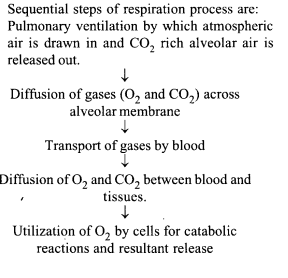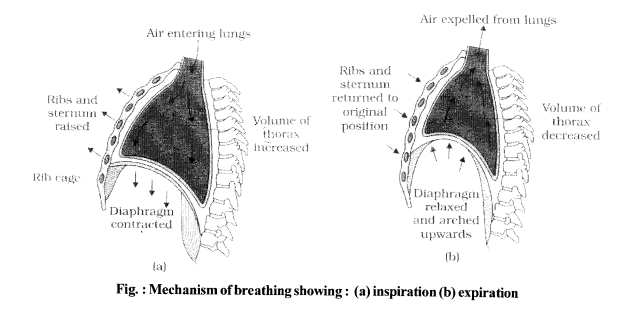NCERT Exemplar Solutions for Class 11 Biology Chapter 17 Breathing and Exchange of Gases
These Solutions are part of NCERT Exemplar Solutions for Class 11 Biology. Here we have given NCERT Exemplar Solutions for Class 11 Biology Chapter 17 Breathing and Exchange of Gases.
VARY SHORT ANSWER QUESTIONS
Question 1.
Define the following terms?
(a) Tidal volume
(b) Residual volume
(c) Asthma
Solution:
(a) Tidal Volume (TV) is volume of air inspired or expired during a normal respiration. It is approx. 500 ml. i. e., a healthy man can inspire or expire approximately 6000 to 8000 mL of air per minute.
(b) Residual Volume : (RV) is volume of air remaining in the lungs even after a forcible expiration. This averages 1100 mL to 1200 mL.
(c) Asthma is an allergic reaction that causes constriction of the bronchiole muscles, thereby reducing the air passage thus the amount of the air that can get to the alveoli.
Question 2.
A fluid filled double membranous layer surrounds the lungs. Name it and mention its important function.
Solution:
Pleural membrane is a fluid filled double membranous layer surrounds the lung. It protects the lung and provides lubrication to it.
Question 3.
Cigarette smoking causes emphysema. Give reason.
Solution:
Emphysema is a chronic disorder of respiratory system, in which inflation or abnormal distension of alveolar wall occurs. Cigarette smoking and the inhalation of smoke or toxic substances over a time period causes the damaging of septa present between the alveoli, and its elastic tissue is replaced by the connective tissue in lungs.
Hence, decreases the respiratory surface and causes emphysema. It causes shortness of breath, production of sputum, chronic bronchitis, etc.
Question 4.
What is the amount of 02 supplied to tissues through every 100 mL of oxygenated blood under normal physiological conditions?
Solution:
Every 100 mL of oxygenated blood can deliver around 5 mL of 02 to the tissue under normal physiological conditions.
Question 5.
A major percentage (97%) of 02 is transported by RBCs in the blood. How does the remaining percentage (3%) of 02 transported?
Solution:
About 97% of 02 is transported by RBCs in the blood. The remaining 3% of 02 is carried in a dissolved state through the plasma.
Question 6.
Complete the missing terms
(a) Inspiratory Capacity (IC) =…..+ IRV
(b) …. = TV + ERV
(c) Functional Residual Capacity (FRC) = ERV+ …..
Solution:
(a) Inspiratory Capacity (IC) = (TV) + (IRV) Tidal Volume. Inspiratory Reserve Volume
(b) Expiratory Capacity (EC) = (TV + (ERV) Tidal Volume. Expiratory Reserve Volume.
(c) Functional Residual Capacity (FRC) = (ERV) Expiratory + (RV) Reserve Volume. Residual Volume.
Question 7.
Name the organs of respiration in the following organisms.
(a) Flatworm …..
(b) Birds ……
(c) Frog …..
(d) Cockroach …….
Solution:
(a) Flatworm General body surface
(b) Birds Lungs
(c) Frog Lungs and moist skin
(d) Cockroach Tracheal tubes.
SHORT ANSWER QUESTIONS
Question 1.
State the different modes of CO2 transport in blood.
Solution:
The blood carries carbon dioxide in three forms.
(i) In dissolved State About 7% of C02 is carried by physical solution. Under normal temperature and pressure.
(ii) As carbamino Compounds – Carbon dioxide binds directly with Hb to form an unstable compound carbaminocompounds (COzHb). About 23% CO2 is transported in this form. When pC02 is high and p02 is low as in the tissues, more binding of CO2 occurs whereas, when pCO2 is low and pO2 is high as in alveoli as tissue dissociation of CO2 from carbamino-haemoglobin takes place.
![]()
(iii) As bicarbonate Ions C02 reacts with water in the presence of carbonic anhydrase to form carbonic acid (H2C03) in RBC H2C03– dissociates into hydrogen and bicarbonate ions (HCO-).
The whole reaction proceeds as follows

The carbonic anhydrase reaction mainly occur in RBC as it contain high concentration of enzyme carbonic anhydrase and minute quantity of it is present in plasma too.
Question 2.
For completion of respiration process, write the given steps in sequential manner.
(a) Diffusion of gases (O2 and CO2) across alveolar membrane.
(b) Transport of gases by blood.
(c) Utilisation of O2 by the cells for catabolic reactions and resultant release of CO2.
(d) Pulmonary ventilation by which atmospheric air is drawn in and CO2 rich alveolar air is released out.
(e) Diffusion of O2 and CO2 between blood and tissues.
Solution:

LONG ANSWER QUESTIONS
Question 1.
Explain the mechanism of breathing with neat labelled sketches.
Solution:
Mechanism of breathing involves two stages:
Inspiration is the process, during which atmospheric air is drawn in expiration is the process by which the alveolar air is released out.
The movement of air into and out ofa the lungs is carried out by creating a pressure gradient between the lungs and the atmosphere, with the help of diaphragm and inter costal muscles.

We hope the NCERT Exemplar Solutions for Class 11 Biology at Work Chapter 17 Breathing and Exchange of Gases, help you. If you have any query regarding NCERT Exemplar Solutions for Class 11 Biology at Work Chapter 17 Breathing and Exchange of Gases, drop a comment below and we will get back to you at the earliest.